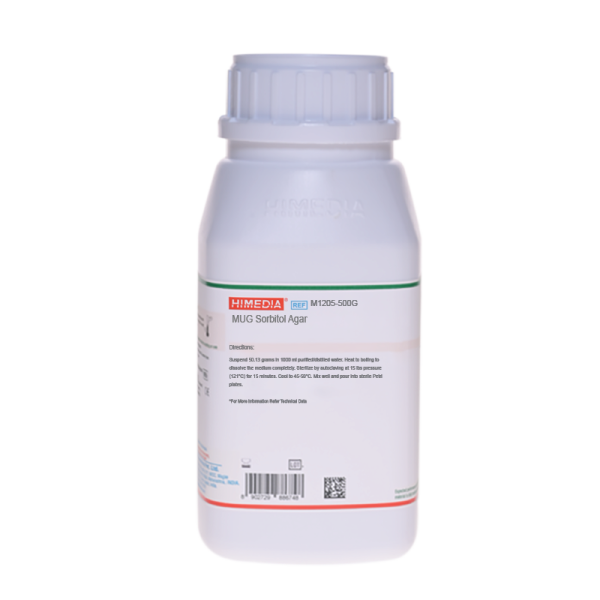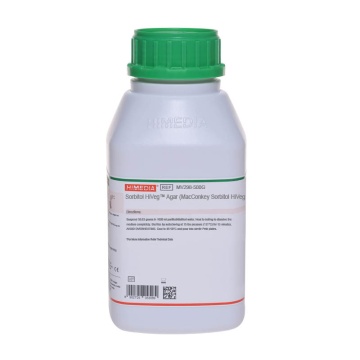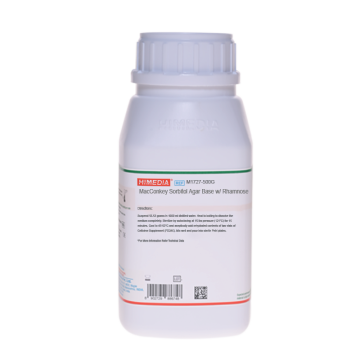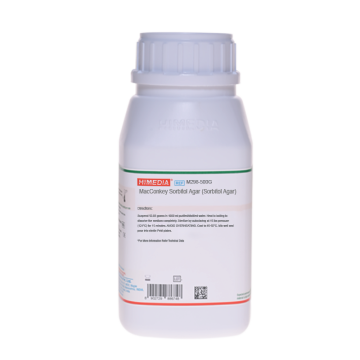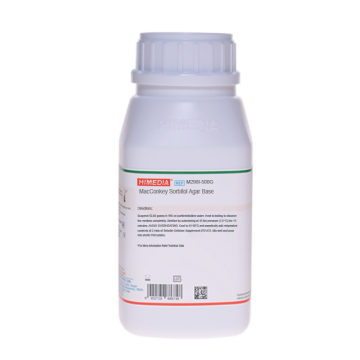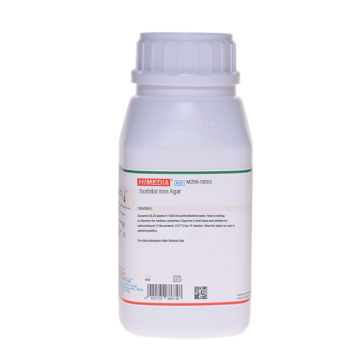 Your enquiry has been submitted
Your enquiry has been submitted
MUG Sorbitol Agar
Intended Use
MUG Sorbitol Agar is used for the isolation and identification of enteropathogenic Escherichia coli associated with infant diarrhea by fluorogenic method.
Composition
| Ingredients | Gms/Litre |
|---|---|
| Peptic digest of animal tissue | 17.000 |
| Proteose peptone | 3.000 |
| D-Sorbitol | 10.000 |
| Bile salts mixture | 1.500 |
| Sodium chloride | 5.000 |
| Neutral red | 0.030 |
| Crystal violet | 0.001 |
| 4-Methylumbelliferyl β-D-Glucuronide (MUG) | 0.100 |
| Agar | 13.500 |
Final pH (at 25°C): 7.1±0.2
Formula adjusted, standardized to suit performance parameters
Directions
Suspend 50.13 grams in 1000 ml distilled water. Heat to boiling to dissolve the medium completely. Sterilize by autoclaving at 15 lbs pressure (121°C) for 15 minutes. Mix well and pour into sterile Petri plates.
Principle And Interpretation
Escherichia coli serotype O157:H7 is a human pathogen associated with hemorrhagic colitis. Most organisms of the faecal flora ferment sorbitol and appear pink on this medium. MUG Sorbitol Agar is a modification of MacConkey Agar using sorbitol instead of lactose. MUG Sorbitol Agar is used for detecting or differentiating enteropathogenic E. coli (EPEC) in water by a fluorogenic method. The distinction of EPEC from other groups of pathogenic E. coli isolated from patients' stools involves serological and cell culture assays. EPEC causes watery diarrhea and bloody diarrhea. Watery diarrhea is associated with attachment and physical alteration of the integrity of the intestine. Bloody diarrhea is associated with attachment of acute tissue destructive process mediated by a toxin called shiga toxin or verotoxin. Shiga toxin is cell associated rather than excreted. Hence the detection or differentiation of this organism is vital from public health point of view.
Among the other strains of E. coli, the enteropathogenic strain lacks the sorbitol degrading ability within 48 hours of incubation. Moreover it does not synthesize the enzyme glucuronidase and hence there is no fluorescence production by this strain when MUG is present in the medium (1). Bile salts mixture and crystal violet in the medium inhibit most of the gram-positive organisms, which accompany the specimen many times. Sorbitol, a polyhydric alcohol corresponding to glucose, serves as a substrate to determine the cleavage of sorbitol by sorbitol degrading microorganisms. Sorbitol degrading microorganisms produce pink to red colonies while sorbitol negative colonies are colourless. MUG (4-Methyl-umbellifery β-D-Glucuronide) is converted into a fluorescent product 4-Methyl-umbelliferone by the β-D-glucuronidase-producing organisms. However enteropathogenic E. coli (in contrast to commensal E. coli strains) does not synthesize this enzyme and thus when its colonies are exposed to long wave UV light, no fluorescence is observed. The plates are exposed to ammonia fumes to increase fluorescence as suggested by Freir and Hartman (4).
It has reported that some Enterobacteriaceae and Pseudomonas aeruginosa are inhibited on this medium when incubated in a CO2-enriched atmosphere (2). The colour of sorbitol- positive colonies can fade, making them hard to distinguish from sorbitol-negative colonies (3).
Quality Control
Appearance: Light yellow to pink homogeneous free flowing powder
Gelling: Firm, comparable with 1.35% Agar gel.
Colour and Clarity of prepared medium: Purplish red coloured clear to slightly opalescent gel forms in Petri plates
Reaction: Reaction of 5.01% w/v aqueous solution at 25°C. pH: 7.1±0.2
pH: 6.90-7.30
Cultural Response
Cultural characteristics observed after an incubation at 35-37°C for 18-24 hours.
| Organism | Inoculum (CFU) | Growth | Colour of colony | Sorbitol | Fluorescence (under UV)* |
|---|---|---|---|---|---|
| Escherichia coli O157:H7 | 50-100 | good-luxuriant | colourless | negative | negative |
| Escherichia coli ATCC 25922 | 50-100 | good-luxuriant | pink-red | positive | positive |
| Staphylococcus aureus ATCC 25923 | >=103 | inhibited |
Key: * Fluorescence can be visualized by addition of NaOH solution or exposure to ammonia fumes.
Storage and Shelf Life
Store below 30°C in tightly closed container and the prepared medium at 2-8°C. Use before expiry date on the label.
Reference
- Szabo R. A., Todd E. C. and Jean A., 1986, J. Food Prot., 10:768.
- Mazura- Reetz, Neblett G. T. and Galperin J. M., 1979, Abstr. C 179, p. 339, Abst. Annu. Med. Am. Soc., Microbiol.
- Adams, 1991, Clin. Lab. Sci., 4:19
- Freir T.A. and Hartman P.A. (1987) Appl. Env. Microbiol. 53. 1246-1250
| Product Name | MUG Sorbitol Agar |
|---|---|
| SKU | M1205 |
| Product Type | Regular |
| Physical Form | Powder |
| Origin | Animal |
| Packaging type | HDPE |
| References | 1. Szabo R. A., Todd E. C. and Jean A., 1986, J. Food Prot., 10:768. |
| Customized Product Available | No |



